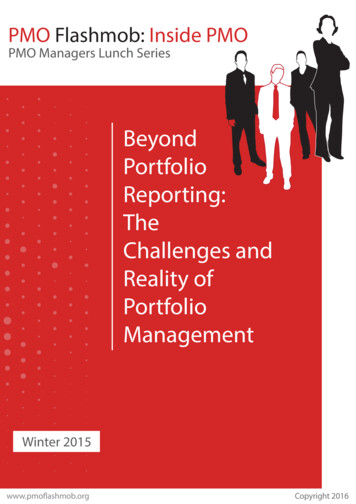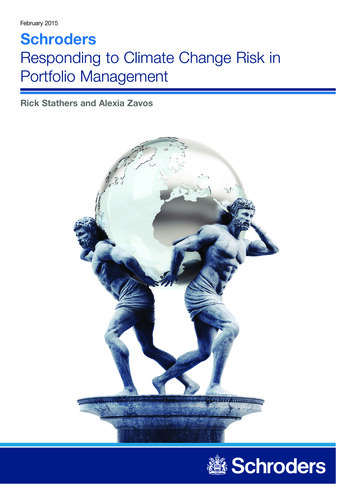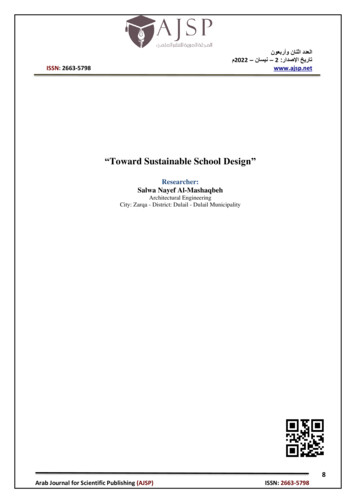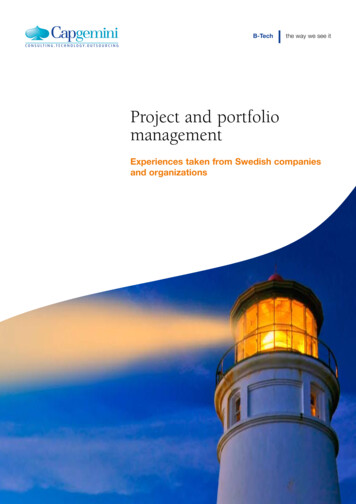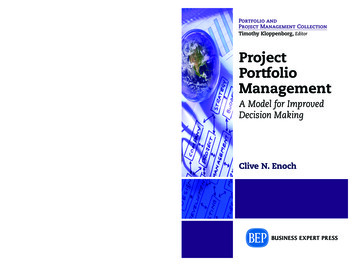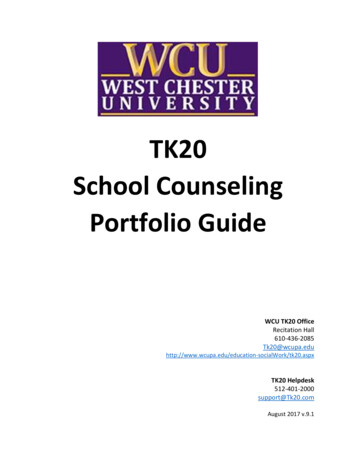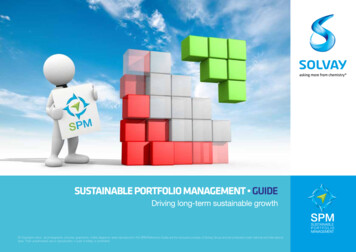
Transcription
SUSTAINABLE PORTFOLIO MANAGEMENT GUIDEDriving long-term sustainable growth Copyright notice : all photographs, pictures, graphisms, charts,diagrams, texts reproduced in the SPM Reference Guide are the exclusive property of Solvay Group and are protected under national and internationallaws. Their unauthorised use or reproduction, in part or totally, is prohibited.
TABLE OFCONTENTSPRINTSUSTAINABLE PORTFOLIO MANAGEMENT GUIDEThis SPM Reference Guide is an easy-to-use guide for applying the SPM tool, improving your sustainability performance and creating morevalue for your business.Chapter One summaries SPM for an executive audience.Chapter Two focuses on the methodology.Chapter Three looks at how the methodology is applied across business areas.Chapter Four provides more detailed information for sustainability practitioners.Chapter Five shares real case studies from the Solvay business.01: Overview04: Assessment for practitionersExecutive summary1.1 S PM in brief1.2 Key decision-making tool4.1 Introduction - The process4.2 Preparation for the SPM assessment4.3 Operations vulnerability – the vertical axis4.3.1 Product segmentation4.3.2 Operations vulnerability assessment4.4 Market alignment – the horizontal axis4.4.1 Market sustainability trends4.4.2 Product Application Combination (PAC)4.4.3 Market alignment questionnaire and categorization4.5 SPM results – Heat map matrix02: Methodology in briefMatrix legend:2.1 Methodology in a nutshell2.2 Scope of SPM2.3 Operations vulnerability: the vertical axis2.4 Market alignment: the horizontal axis2.5 Mapping results – SPM heat map2.6 Auditability for reliable data2.7 External recognition05: Case studiesVertical axis03: K ey decision-making toolHorizontal axisBoth horizontal &vertical axis 2 3.1 Strategy3.2 Research & Innovation (R&I)3.3 Capital expenditures (CAPEX) projects3.4 D ue diligence on Merger & Acquisition (M&A) projects3.5 Marketing & Sales3.6 SPM toolkitOverviewMethodologyin briefKey decision-makingtool5.1 Sodium carbonate in double glazing5.2 Optalys in gasoline depollution5.3 Paramove hydrogen peroxide in fish farmingAnnex 1: MethodologyAnnex 2: Q&AAnnex 3: GlossaryAssessmentfor practitioners SolvayTable ofContentsSEARCHCase studiesAnnexes
01TABLE OFCONTENTSSUSTAINABLE PORTFOLIO MANAGEMENT GUIDEOverviewJean-Pierre Clamadieu Peter Bakker“Our sustainable Solutions reached43% of Solvay sales in 2016 whileour Challenges decreased to 8%.“Sustainability is one of the essential driving force of Solvaystrategy. The “SPM” or Sustainability Portfolio Management toolis like a compass. It makes our strategy more robust and addsvalue in the key business, innovation and investment decisions.This SPM guide helps to demystify the tool, show its strengthsand its limitations. We explain simply how we evaluate for eachproduct/application both the impact of its production on theenvironment and the benefit or challenge to the planet and thesociety. The scientific approach, rigorous analysis and systematicexternal references are the guarantees for excellence and neutralevaluations.We are proud of the current momentum. Best Solutions reaching43% of our sales in 2016 while our Challenges decreased to8%. Let us continue the journey to a better world, developingsustainable and differentiated offer using SPM as an assetJean-Pierre ClamadieuCEO, Solvay 3 OverviewMethodologyin briefKey decision-makingtool“The business case for sustainable development isstrong: it opens up new business opportunities, bigefficiency gains and it drives innovation. The Business &Sustainable Development Commission research showsthat achieving the Sustainable Development Goalscould be worth an estimated 12 trillion USD every yearby 2030 in business savings and new revenue, creating380 million jobs in the process. In order to make theright decisions in their business processes, companiesneed to adopt robust, reliable and practical tools.WBCSD is engaged with leading chemical companies,in particular Solvay, to develop a common frameworkand methodology to steer companies’ productportfolios to higher sustainability standards.”Peter BakkerPresident, WBCSDhttp://www.wbcsd.org/Assessmentfor practitionersCase studiesAnnexes SolvayJean-Pierre Clamadieu
01TABLE OFCONTENTSSEARCHPRINTSUSTAINABLE PORTFOLIO MANAGEMENT GUIDEOverviewThe SPM global and systematic assessment helps alert the business to sustainability marketsignals, even weak ones, to anticipate their impact and develop the right answers in a timely way.It enables value to be captured in emerging eco systems and helps business to grow its portfolioby levering on opportunities and turning challenges into solutions.The Sustainable Portfolio Management (SPM) is a fact based and robust compassto steer Solvay’s portfolio toward better business because more sustainable.SPM is designed to boost Solvay’s business performance and deliver higher growth.With SPM, decision-makers are informed on the contribution of Solvay’s products tosustainability considering both: Their environmental manufacturing footprint and its correlated risksand opportunities – vertical axis – quantitative assessment by 19 impactindicators. H ow in their applications they bring benefits or faces challenges ina market perspective – horizontal axis – qualitative assessment by 60questions on social and environmental topics.Over the last three years, Solvay’s products have experienced significantly differentannual revenue growth rates depending on whether customers and consumers areseeking out Solvay’s products to match their unmet social or environmental needs.SPM category Solutions (unmet needs to achieve higher social or environmentalstandards) shows an annual growth rate of 9% while Challenges (sustainabilityconcerns or roadblocks) ends up at -3%.“SPM is instrumental at Solvayto take robust decisions byintegrating sustainability in itsbusiness growth ambition. SPMis a key tool to understand theoperational and market-inducedrisks and opportunities related tothe environmental impact of ourfacilities against the contribution of ourproducts to the planet and society.We are engaging in open innovationand dialog with our key partners andare committed to sustainable growth.”Measuring sustainability in business terms:SPM is a key tool to integrate the sustainability dimension in strategic and operationaldecisions of key business processes: strategy, research and innovation, investment,marketing and sale, merger and acquisition.Pascal Chalvon DemersayChief Sustainability Officer, Solvay SolvayA tool to help GBU contribute to the Group’s ambition:Within Solvay, Global Business Units (GBUs) are accountable for delivering theambitious Group target for sustainable business performance: by 2025, realize 1of revenue out of every 2 in sustainable solutions. 4 OverviewMethodologyin briefKey decision-makingtoolAssessmentfor practitionersCase studiesAnnexes
01OverviewTABLE OFCONTENTSSEARCHPRINTSUSTAINABLE PORTFOLIO MANAGEMENT GUIDE1.1 S PM TOOL INTEGRATED IN THETHE SUSTAINABLE DEVELOPMENT AMBITION OF THE SOLVAY GROUPThe Solvay Way is the continuous improvement approach which integrates social, societal, environmental and economic aspects into theCompany’s management and strategy, with the objective of creating value. It takes into account society’s changing expectations, requiringindustry to develop technology, processes, products, application and services that are in line with the objectives of sustainabledevelopment.TheCustomersis an exceptional onboarding tool to deliver our ambition and commitments towards our six main stakeholder groups:EmployeesSuppliersInvestorsPlanetSocietyThe SPM tool clearly addresses all thecharacteristics of the CircularEconomy which is at the heart of ourvision to create more value for thefuture through the development ofsustainable .org 5 OverviewMethodologyin briefKey decision-makingtoolAssessmentfor practitionersCase studiesAnnexes SolvayThe Group has set ambitiousextra-financial objectives by 2025positioned in three circles:1. H ow we contribute to societybeyond our responsibility as achemist (societal actions)2. H ow we bring SustainableSolutions to the market throughinnovation (SPM)3. H ow we act responsibly (with mainindicators on safety, peopleengagement and environmentalfootprint)
01OverviewTABLE OFCONTENTSSEARCHPRINTSUSTAINABLE PORTFOLIO MANAGEMENT GUIDE1.2 KEY DECISION-MAKING TOOLSPM tool aims to integrate sustainable development into strategic and operational level decision-making covering a wide scope ofmanagement processes: Portfolio management decisions and differentiation strategy Strategic project-related decisions in Research and Innovation (R&I), capital expenditures (CAPEX) and Mergers and Acquisitions (M&A) Product footprint improvementFrom 2016, within Solvay, the methodology is applied in: More than 80% of the existing product portfolio in a consistentway (i.e. total sales revenue) All R&I projects All CAPEX projects for requests above 10 million EUR All M&A projectsSince SPM is a pragmatic decision-making tool, it is adaptedto different information needs, time and resources available.Roger KearnsMember of the Executive Committee, Solvay SolvayThe SPM tool combines pragmatism, adaptability, scientificjustification and process reliability and leads to more valuecreation through a robust and more differentiated strategy.“What is unique about Solvay’ssustainable solutions? They makemoney – we do not need to makea choice between sustainability andprofitability. SPM is like a compass,steering us towards the rightinvestments, research projects andportfolio decisions.” 6 OverviewMethodologyin briefKey decision-makingtoolAssessmentfor practitionersCase studiesAnnexes
PRINTSUSTAINABLE PORTFOLIO MANAGEMENT GUIDE2.1 METHODOLOGY IN A NUTSHELLThe SPM tool in Solvay is often referred to as a camera as it takes a snapshot of product’s sustainability risks andopportunities in their business environment. It develops a dynamic vision of sustainability market signals and their potentialimpact on portfolio and strategic projects helping the business: Take the right decisions to address successfully sustainability needs of the marketplace To meet customers and stakeholders expectations both today and tomorrow.The SPM snapshot is projected on a heat map matrix where products in their applications are plotted according to threeattributes (see figure below):SPM mapping:It analyzes whether one product in a givenapplication is part of the sustainable developmentsolution or part of the problem from a consumer andmarket perspective.3. Sales volumes are also taken into account andrepresented in the SPM Heat Map with the darkershading representing the revenue at stake. 7 OverviewMethodologyin briefChallengedExposedNeutralAlignedStarMarket AlignmentThe SPM assessment is performed in close cooperation with Business Units withstrict quality control and external expert review. The results are recorded in a globalSPM Database and are fully auditable.Key decision-makingtoolAssessmentfor practitionersCase studies Solvay2. Market Alignment (horizontal axis)of products in their application analyzes themarket signals of sustainability benefits androadblocks and categorizes products on a five-scalespectrum from ‘challenged’ to ‘star potential’.An area representsone or severalproducts in theirapplication.The shadingintensity dependson sales volume: thedarker the color, thehigher the turnoverMedian RiskThe lower the ratio, the higher the probability todisplace a less environmental-friendly competingtechnology.Operations VulnerabilityThe higher the ratio, the higher the risk for Solvay oflosing business to more sustainable solutions.Low RiskVery Low Risk1. Operations Vulnerability (vertical axis) isthe ratio of monetized environmental footprintof products over their sales value. In other words, itis the monetized environmental manufacturingfootprint per 1 EUR of revenue.High RiskMethodologyin briefSEARCHVery High Risk02TABLE OFCONTENTSAnnexes
02Methodologyin briefTABLE OFCONTENTSSEARCHPRINTSUSTAINABLE PORTFOLIO MANAGEMENT GUIDE2.2 SCOPE OF SPMThe SPM tool covers:1) Operation vulnerability: the upstream, cradle-to-gate scope of the value chain to define sustainability-related business risksand opportunities based on a quantitative LCA. 19 product impact points analyzed, monetized and compared to sales valueusing LCA methodology.2) Market alignment: the entire value chain (up and downstream), cradle-to-grave to pinpoint sustainability benefits androadblocks in the product portfolio applying evidence-based analysis of market signals.Cradle-to-Gate - Upstream Value ChainEnvironmental impacts monetized using shadow costs ( )Water ( )Gate-to-Cradle - Downstream Value ChainSignals captured from: regulators, NGOs, IOs, clients,consumers on sustainability trendsEmissions ( )SupplierEnergy ( )CustomerWholesaleConsumerLand use ( )Extraction ( )Before SOLVAYSOLVAYAfter SOLVAY(further processing)Use PhaseEnd-of-Life/Recycling SolvayOperations vulnerability analysisMarket alignment analysis 8 OverviewMethodologyin briefKey decision-makingtoolAssessmentfor practitionersCase studiesAnnexes
02Methodologyin briefTABLE OFCONTENTSSEARCHPRINTSUSTAINABLE PORTFOLIO MANAGEMENT GUIDE2.3 OPERATIONS VULNERABILITY: THE VERTICAL AXISOperations Vulnerability is the quantitative element of the SPM analysis. It evaluates any potential financial riskand opportunity posed by the environmental footprint of products according to the ‘polluter pays’ principle.A unique approach combining scientific analysis with risk assessment.Operations Vulnerability calculation steps:Step 1:Impact AssessmentStep 2:Impact Valuation1. Calculation of a product’s ecoprofile. We calculate the ecoprofile of a product using a Life-Cycle Assessment(LCA) performed by our in-house experts in line with the ISO 14040 and ISO 14044 standards.With this procedure, we create an inventory of impacts on surrounding ecosystems e.g. resource consumption,emissions to soil, air and water, including human toxicity potential, of a product occurring upstream from extraction,through production, until it leaves Solvay’s premises (in a cradle-to-gate approach). 19 indicators of impacts are used.2. Monetization of negative impacts. We use ‘shadow costs’ drawn from authoritative scientific sources to definewhat it would cost to remedy or prevent negative impacts.These are costs which Solvay does currently not incur, i.e. they have not been internalized yet. The impact valuationdefines the financial risk of internalizing these negative impacts.3. Financial risk of negative impacts (externalities). The risk of losing business or the opportunity of gainingnew business depends on the balance between the economic value and the damage that is created.The absolute financial value of the potential impacts of one kg of product is insufficient to inform the decision-maker.That is why we calculate the implications of the financial impacts by dividing the value of the impacts by the salesvalue of the product. The result is the Operations Vulnerability ratio expressed as a percentage, which can rangefrom 2% to over 200% of the sales value for some products. This ratio is plotted on the vertical axis of the heat map. SolvayStep 3:Operations Vulnerability 9 OverviewMethodologyin briefKey decision-makingtoolAssessmentfor practitionersCase studiesAnnexes
02TABLE OFCONTENTSSEARCHPRINTSUSTAINABLE PORTFOLIO MANAGEMENT GUIDEMethodologyin brief2.4 MARKET ALIGNMENT: THE HORIZONTAL AXISQualitative, evidence-based collection of sustainability-related market signalsConsumers and stakeholders across the value chain (manufacturers,wholesale and retail) are putting more and more emphasis onsustainability.In order to understand the risks and opportunities arising in the valuechain, the right signals have to be captured from different stakeholders.Similar approaches from Solvay’s peers, such as AkzoNobel, BASF,Clariant, DSM and Evonik among others, have shown that a qualitativeor semi-quantitative analysis is best adapted to interpret signals1.The Market Alignment analysis of PACs consists of two steps:Step 1:Market AlignmentProfiling(via questionnaire)Step 2:Market AlignmentCategorization(via decision tree)Step 1: Market Alignment Profiling: To identify the sustainabilitysignals for each PAC, a Working Group of the SPM expert andBusiness Unit answer the 60-question questionnaire on environmentaland social issues to collect information on obstacles, concerns,benefits, high-growth (Star) potential and amplifiers.We analyze products in their end-user applications, based onProduct-Application Combinations or PACs. One product canhave several PACs.Step 2: Market Alignment Categorization: The information gatheredis applied to a decision tree, which positions the product on a 1-5 scaleof Challenged (1), Exposed (2), Neutral (3), Aligned (4), Star (5). SolvayFull cradle-to-cradle Life-Cycle Analysis is not material for Solvay as itis limited to environmental impact assessment, while SPM analysis alsoaddresses social issues such as healthcare, ageing population andhealthy living. We defined these questions based on the analysis of anumber of different authoritative sources to understand whatsustainability means for a chemist and for chemical products. Theresult is a questionnaire with 60 questions.Our benchmark shows that quantitative, e.g. monetized analysis of impacts occurring in the entirevalue chain requires lengthy and costly procedures that are difficult to use in fast-paced strategiccorporate decision-making cycles, as well as in operational decisions on allocation of future spendingsuch as innovation projects.1 10 OverviewMethodologyin briefKey decision-makingtoolAssessmentfor practitionersCase studiesAnnexes
02TABLE OFCONTENTSSEARCHPRINTSUSTAINABLE PORTFOLIO MANAGEMENT GUIDEMethodologyin brief2.4 MARKET ALIGNMENT: THE HORIZONTAL AXISQualitative, evidence-based collection of sustainability-related market signalsAll the sustainability signals assessed using thequestionnaire are run through a decision tree. Thisdefines the exact positioning of the Product-ApplicationCombination or PAC. First, we look at Obstacles andConcerns (Steps 1 and 2). Any Obstacle identified willimmediately rank the PAC as Challenged and anythingraising Concern as Exposed.Then we turn our attention to the positive signals (Steps 3-5). If we findno negative and no particularly positive impacts, we categorize the PACas Neutral (Step 3). If the PAC analyzed demonstrates a direct,significant and measurable benefit to the market, impacting positivelyupon at least one of the sustainability benefits assessed, we list theproduct as Aligned (Step 4). If in addition, we register double-digitgrowth potential in sales forecasts, the PAC is categorized as Star (Step5).Fast track SPM Market Alignment decision tree:STEP 2NOSTEP SEDSTEP 4NEUTRALSTEP 5FASTGROWINGNOALIGNEDYESSTARAll the answers are also recorded in the Global SPM Database and are fully-auditable.The override option. The market alignment decision tree aims at identifying market signals without any compromise on negative signals and regardless their materialitylevel. Therefore the results may look counter intuitive with regards to observed market trends. The SPM expert after analysis may decide as per clear exception tooverride the market alignment results provided that a deeper investigation will be carried on the PAC with a review by a third party. The PAC under override procedurewill be by default part of annual review by third party Arthur D.Little. For transparency’s sake the number of PACs under override as their turnover at stake will bereported.Reviews of the Market Alignment methodology application are conducted on a regular basis by Arthur D. Little (ADL). The % of the product portfolio assessed and the% of sustainable solution published in Solvay’s 2016 annual report have been reviewed by Deloitte (reasonable assurance). 11 OverviewMethodologyin briefKey decision-makingtoolAssessmentfor practitionersCase studiesAnnexes SolvaySTEP 1
02Methodologyin briefTABLE OFCONTENTSSEARCHPRINTSUSTAINABLE PORTFOLIO MANAGEMENT GUIDE2.5 MAPPING RESULTS – SPM HEAT MAPResults of the Operations Vulnerability and Market Alignment assessments are plotted on a heat map whichshows how risky the PAC is for Solvay.Business Units receive a drilled-down report which allows them to analyze the PAC’s position on the heat map andsuggest actions to maintain or improve performance and reach Group-level targets.Product applications on the SPM Heat Map:Very Low RiskThe heat map is the highest-level portfolio steering instrument of the SPMassessment. It categorizes products and PACs in three higher level categoriesMedian Risk Challenges: PACs for which there are either strong negative signals resultingfrom sustainability drivers in the marketplace, or serious operationsvulnerability challenges.These are products where there may be a significant negative impact on revenueover time and where products may eventually disappear.High RiskInert chemical used in therolling band of tires with EUEcolabel for fuel efficiency inC or D categoryOver the last three years, Solvay’s products have experienced significantly differentannual revenue growth rates depending on whether customers and consumers areseeking out Solvay’s products to match their unmet social or environmental needs.Products in applicationsconstitute each squareshaped areaAnnual growth rate per SPM category: Solutions (unmet needs to achieve higher social or environmental standards): 9%ExposedNeutralMarket AlignmentOverviewMethodologyin briefAlignedStar(based on turnover with same product, same application and same SPM rankingover the last 3 years representing 45% of Group revenue).SPM global and systematic assessment involves an evaluation of the portfolio for agiven year (Y) based on the turnover of the previous year (Y-1). Changes in the businessperimeter during the year are taken into account in the scope of the year (Y) SPM.Key decision-makingtoolAssessmentfor practitionersCase studiesAnnexes Solvay Challenges (sustainability concerns or roadblocks): -3%Challenged 12 Neutral: PACs which do not have outstanding sustainability performance,if any. Low Operations Vulnerability is not combined with favorable sustainabilitydrivers in the marketplace. These are products that consumers need, but whichdo not contribute to environmental footprint reductions.Bio-based chemical used inhair care with strong marketpull for bio-based ingredientsVery High RiskOperations VulnerabilityLow Risk Solutions: PACs with a better sustainability contribution to Solvay customersand value chain, combined with a favorable balance between value andenvironmental impact.
02Methodologyin briefTABLE OFCONTENTSSEARCHPRINTSUSTAINABLE PORTFOLIO MANAGEMENT GUIDE2.6 AUDITABILITY FOR RELIABLE DATAIn order to integrate the results of the SPM assessment to strategic and operational planning, we developeda sustainability assessment framework which could be audited by third-party accounting and sustainabilityassessment experts.1. Dedicated data management module for SPMData from both axes of the SPM assessment are documented andrecorded in Solvay’s Global SPM Database. A user-friendly moduledeveloped in-house and hosted in the SAP system allows around1,500 SPM assessments (PAC) to be carried out per year.1. Dedicateddata managementmodule2. Specialized sustainability methodology audits3. Statutory auditor limited to reasonable assuranceEach year, we report Group-level turnover breakdown following theSPM Heat Map categories (Challenges, Neutral and Solutions).The % of the product portfolio assessed and the % of sustainablesolutions published in Solvay’s 2016 annual report have been reviewedby an independent third party (reasonable assurance). 13 OverviewMethodologyin briefKey decision-makingtool2. ,strategicplanningproof system3. Statutoryauditor’sreasonableassurance(2016) SolvayThird-party verification of the Market Alignment assessments is carriedout by Arthur D. Little (ADL) at PAC level. Every year ADL screens allthe PACs in the database and selects 150 PACS for deeper review,75 with higher value for Solvay based on multiple criteria and 75 on arandom basis. In addition, Solvay submits 50 PACs per year to ADL forreview. PACs under override procedure are part of the review as well.All the PACs in the database will be reviewed every five years at thelatest.Assessmentfor practitionersCase studiesAnnexes
02TABLE OFCONTENTSSEARCHPRINTSUSTAINABLE PORTFOLIO MANAGEMENT GUIDEMethodologyin brief2.7 EXTERNAL RECOGNITIONAwardEFQM ‘HighlyCommended’ 2011Sustainable PortfolioManagementRecognition European Commission, DGEnterprise & Industry SusChem, EuropeanTechnology Platform forSustainable Chemistry Kohlberg Kravis Roberts(KKR) - global investmentfirm CIRAIG (with whom Solvayalso embarked on a highlevel research platform onLCA methodologies) U micore ArcelorMittal (as a buyerof Solvay products in ourvalue chain)Matt FisherCOO, EFQM The Conference Board 14 OverviewMethodologyin briefKey decision-makingtoolAssessmentfor practitionersPromotedas Best PracticePartnerships TNO to advance scientificresearchhttp://www.csreurope. WBCSD to advanceorg/solvay-sustainablesectoral Portfolio Steeringportfolio-management-spm#.Assessment (within theWEfkkXeZNBwframework of Action2020 T he World Business– Business Solutions onCouncil for Sustainablesafe products)Development (WBCSD): CSR EuropeCollaboration, innovation,transformation - ideas andinspiration to acceleratesustainable growth - Avalue chain approach;2011, page 14 and 15 ICIS or-sustainableinnovation/Case studies Solvay““Solvay’s Sustainable PortfolioManagement approach receiveda ‘Highly Commended’ awardin EFQM’s Sustainability GoodPractice Competition. TheJury recognized that the toolrepresents a paradigm shift inthe way organizations considersustainability as part of theirstrategic planning process andthe potential for this tool to beadapted and applied in otherorganizations and sectors.”Annexes
03TABLE OFCONTENTSSEARCHPRINTSUSTAINABLE PORTFOLIO MANAGEMENT GUIDEKey decisionmaking tool‘ASK NEW QUESTIONS, GET NEW ANSWERS!’SPM is a compass to help key business processes integrate the sustainability dimension.‘Ask new questions, get new answers!’ is the SPM motto to help the business differentiate and create more value.At Solvay, the SPM tool is the compulsory analytical tool to be applied before decisions are made in Strategy, Research & Innovation(R&I), Marketing & Sales, Capital Expenditure (CAPEX) and as an element of due diligence in Mergers and Acquisitions (M&As).MARKETING & SALESM&ACAPEX SolvayINNOVATIONSTRATEGY 15 OverviewMethodologyin briefKey decision-makingtoolAssessmentfor practitionersCase studiesAnnexes
03Key decisionmaking toolTABLE OFCONTENTSSEARCHPRINTSUSTAINABLE PORTFOLIO MANAGEMENT GUIDE3.1 STRATEGYStrategic projects are key to achieving Group-level targets in general and the business portfolio-related targets in particular.SPM helps deliver on the non financial target that 50% of Solvay’s revenue should come from products which offer sustainablesolutions and therefore the SPM approach is fully-integrated in the strategy process that each Business Unit has to undergoduring its annual Business Strategic Review (BSR).SPM in ProjectsThe SPM tool is therefore applied to strategic projects ina similar logic to make sure that they are heading towardbusiness solutions to support growth and value creation.Fast track assessments are used especially in the earlystages of projects where it is not practical or not possibleto commit more resources to in-depth analysis due totime and/or financial constraints. It allows to integratesustainability dimension among others from the beginningof the project.The SPM logic around project assessment is to: P repare an SPM snapshot of the starting point and theanticipated end-point of any project and continuouslyreview the latter as the project evolves P osition the project within the BU/GBU portfolio whereit belongs P osition the projects in the corresponding Solvay Waypractice and maturity level and link them to Grouptargets““SPM is an unmatched tool when Novecare is making portfoliodecisions. It enhances our ability to align our strategies andpractices that contribute to providing sustainable solutions,while simultaneously supporting our customer approach.”Emmanuel ButstraenPresident GBU Novecare, SolvayGBU Specialty Polymers started applying the SPM tool in 2009,speeding up its sales growth when the economy reboundedin 2010. Since then, repeatedly reassessing our sales and R&Iinvestments with SPM has given us a better alignment andfocus on fast-growing sustainable emerging markets.”Augusto Di DonfrancescoPresident GBU Specialty Polymers, Solvay 16 OverviewMethodologyin briefKey decision-makingtool SolvayAll SPM snapshots are taken by the SPM team and arelinked to financial performance bridges in a similar way asin the Business Strategy Review process. (explainedabove).Assessmentfor practitionersCase studiesAnnexes
03TABLE OFCONTENTSSEARCHPRINTSUSTAINABLE PORTFOLIO MANAGEMENT GUIDEKey decisionmaking tool3.2 RESEARCH & INNOVATION (R&I)As of 2013, 100% of R&I projects are analyzed with the SPM tool. Using SPM logic, a product is analyzed in a so-called stage-gateprocess starting already at the ideation phase with the use of version of Fast track version of the SPM tool within each phase.MThe Fast track SPM version is a list of six
Since SPM is a pragmatic decision-making tool, it is adapted to different information needs, time and resources available. The SPM tool combines pragmatism, adaptability, scientific justification and process reliability and leads to more value creation through a robust and more differentiated strategy. " What is unique about Solvay's
